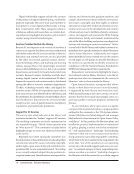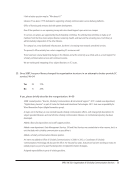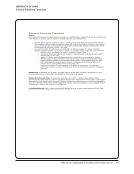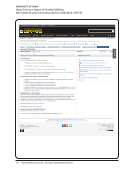12 · Survey Results: Executive Summary
three reported that SC leadership was not associated
with any single individual or group.
An analysis of respondents’ comments indicates
this forced choice does not accurately describe the
actual distribution of responsibility. Organizational
changes are one reason. One library recently trans-
ferred SC leadership from a committee to a single
position. In at least three instances, SC leadership had
been, or was soon to be, transformed by the creation
of a new office or unit. Another reason is that multiple
leadership structures exist within many of the librar-
ies. As one respondent explained, “We actually have a
combination of the three instances above: we have an
individual who tends to lead the scholarly communi-
cation efforts, a scholarly communications committee,
and a (new) unit where these activities rest….”
Individual Leader
The 17 individuals who lead SC efforts are mostly
assistant/associate directors, department or program
heads, and scholarly communications librarians. All
but two report to the library director or assistant/asso-
ciate director. Their titles indicate their responsibilities
range across collections and technical services, re-
search and instruction, digital services, copyright and
licensing, and publishing. Eight have special training
or degrees related to their SC responsibilities. These
include law degrees, publishing experience, copyright
and licensing training, and attendance at the ARL/
ACRL Institute on Scholarly Communication. Nine
have direct reports ranging from .75 to 6 FTE (on aver-
age, 1.19 FTE librarians and .76 FTE staff). Four have at
least one FTE librarian reporting to them. Four have
at least one FTE staff. While the other eight have no
direct reports, several have support from SC steering
committees and other librarians. These individuals
devote between 1% and 100% of their time to SC ef-
forts, with an average of 53%. The table below indicates
how much time 16 of these individuals spend leading
SC efforts at their institutions.
%Time N %
25% 3 19
25-50% 6 38
75% 7 44
Library Office, Department, or Unit
The names of all but a few of the 14 offices that lead SC
efforts include the phrase “scholarly communication.”
The names indicate that other responsibilities include
collections, digital services, copyright, and publish-
ing. The number of staff in these offices ranges from
one to 20, with an average of seven. Most of these are
full-time staff (average 6.1 FTE) and the office names
suggest that SC efforts make up a significant aspect
of each position’s responsibilities. In half of the offices
at least one person has special training in copyright
or licensing or has a law degree. Most of the heads of
these offices report to the library director. The table
below shows the range of staff across these 14 offices.
Total Staff N %
1 1 7
3–4 6 43
5–9 3 21
≥10 4 29
Two or More Individuals in the Library
Of the 13 libraries where multiple individuals have
primary responsibility for SC leadership, four (31%)
report that two individuals share leadership roles and
six (46%) report three individuals share leadership
roles. Three respondents did not specify the number of
individuals. The respondents reported on 34 positions
ranging from a library dean and assistant directors to
department and program heads to various other li-
brarians. The responsibilities reflected by the position
titles are as wide-ranging as reported above.
Eighteen positions (54%) report to the library direc-
tor. Three libraries have a direct chain of command
leading to the dean (e.g., position 2 is overseen by
position 1, and position 1 is overseen by the dean).
Four libraries have two or more positions reporting
to the same individual (e.g., there are three separate
positions, and each reports to the same dean). Five
are set up in a distributed way, with positions re-
porting to different deans, associate deans, or heads.
One institution uses a combination of these latter two
arrangements.
Nineteen of these SC leaders have direct reports 12
have between .25 and 1 FTE, four have 2 to 5 FTE, and
three reported that SC leadership was not associated
with any single individual or group.
An analysis of respondents’ comments indicates
this forced choice does not accurately describe the
actual distribution of responsibility. Organizational
changes are one reason. One library recently trans-
ferred SC leadership from a committee to a single
position. In at least three instances, SC leadership had
been, or was soon to be, transformed by the creation
of a new office or unit. Another reason is that multiple
leadership structures exist within many of the librar-
ies. As one respondent explained, “We actually have a
combination of the three instances above: we have an
individual who tends to lead the scholarly communi-
cation efforts, a scholarly communications committee,
and a (new) unit where these activities rest….”
Individual Leader
The 17 individuals who lead SC efforts are mostly
assistant/associate directors, department or program
heads, and scholarly communications librarians. All
but two report to the library director or assistant/asso-
ciate director. Their titles indicate their responsibilities
range across collections and technical services, re-
search and instruction, digital services, copyright and
licensing, and publishing. Eight have special training
or degrees related to their SC responsibilities. These
include law degrees, publishing experience, copyright
and licensing training, and attendance at the ARL/
ACRL Institute on Scholarly Communication. Nine
have direct reports ranging from .75 to 6 FTE (on aver-
age, 1.19 FTE librarians and .76 FTE staff). Four have at
least one FTE librarian reporting to them. Four have
at least one FTE staff. While the other eight have no
direct reports, several have support from SC steering
committees and other librarians. These individuals
devote between 1% and 100% of their time to SC ef-
forts, with an average of 53%. The table below indicates
how much time 16 of these individuals spend leading
SC efforts at their institutions.
%Time N %
25% 3 19
25-50% 6 38
75% 7 44
Library Office, Department, or Unit
The names of all but a few of the 14 offices that lead SC
efforts include the phrase “scholarly communication.”
The names indicate that other responsibilities include
collections, digital services, copyright, and publish-
ing. The number of staff in these offices ranges from
one to 20, with an average of seven. Most of these are
full-time staff (average 6.1 FTE) and the office names
suggest that SC efforts make up a significant aspect
of each position’s responsibilities. In half of the offices
at least one person has special training in copyright
or licensing or has a law degree. Most of the heads of
these offices report to the library director. The table
below shows the range of staff across these 14 offices.
Total Staff N %
1 1 7
3–4 6 43
5–9 3 21
≥10 4 29
Two or More Individuals in the Library
Of the 13 libraries where multiple individuals have
primary responsibility for SC leadership, four (31%)
report that two individuals share leadership roles and
six (46%) report three individuals share leadership
roles. Three respondents did not specify the number of
individuals. The respondents reported on 34 positions
ranging from a library dean and assistant directors to
department and program heads to various other li-
brarians. The responsibilities reflected by the position
titles are as wide-ranging as reported above.
Eighteen positions (54%) report to the library direc-
tor. Three libraries have a direct chain of command
leading to the dean (e.g., position 2 is overseen by
position 1, and position 1 is overseen by the dean).
Four libraries have two or more positions reporting
to the same individual (e.g., there are three separate
positions, and each reports to the same dean). Five
are set up in a distributed way, with positions re-
porting to different deans, associate deans, or heads.
One institution uses a combination of these latter two
arrangements.
Nineteen of these SC leaders have direct reports 12
have between .25 and 1 FTE, four have 2 to 5 FTE, and














































































































































































